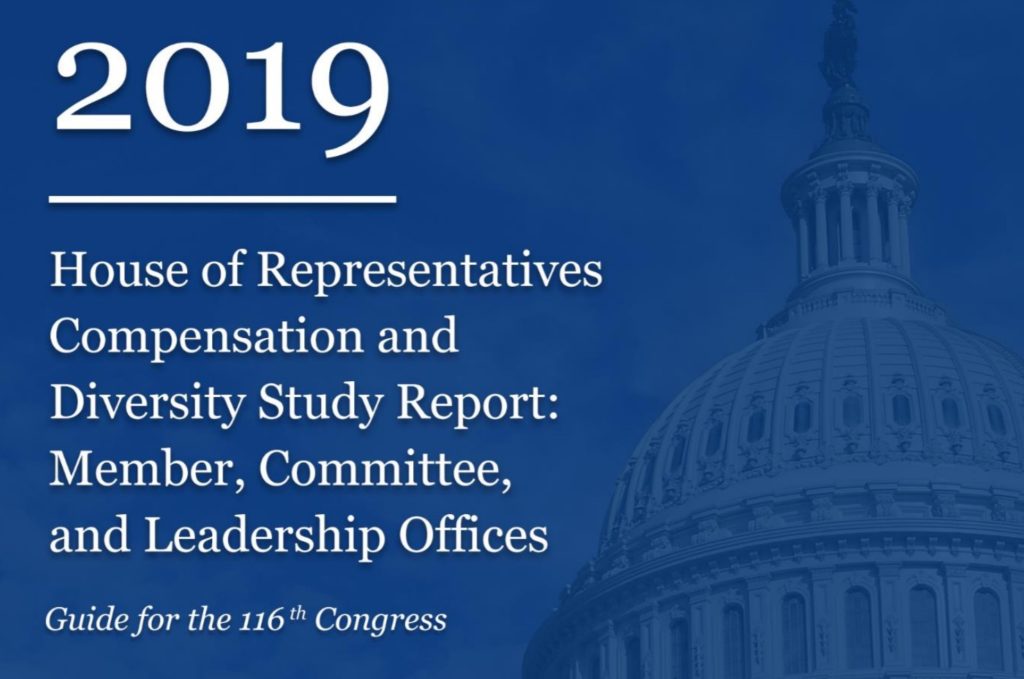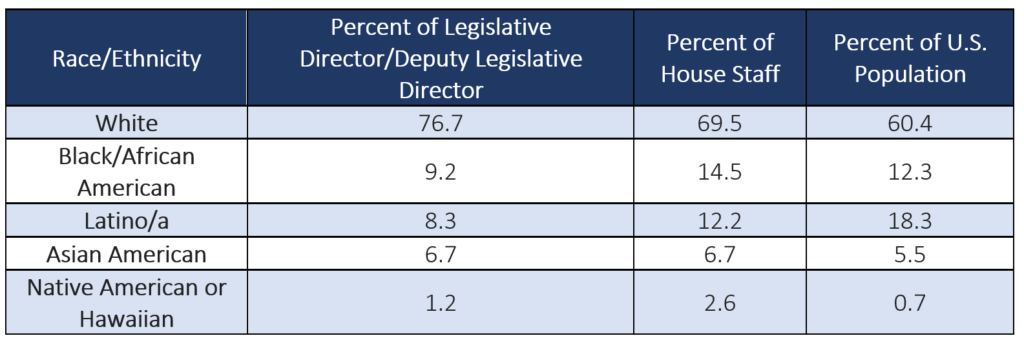Hill Diversity

House-Wide Compensation and Diversity Study Shows African Americans and Latinos are Underrepresented Among Key Roles in the U.S. House
On September 26, 2019, the U.S. House of Representatives released results from its study on diversity and compensation. The study is based on findings from a web-based survey on compensation, benefits, and demographics sent to all 10,356 House staff across all Member offices, committee offices, leadership offices, and House officer offices. Of all House staff, 51 percent (5,290) participated in the survey. The study does not disclose the partisan breakdown of survey respondents.
The Joint Center’s analysis finds that of those House staff who responded to the survey:
- The U.S. House’s percentage of Black staff (14.5 percent) is higher than the percentage of the Black population in the U.S. (12.3 percent). However, African Americans are underrepresented when compared to the percentage of African Americans in key roles such as chief of staff/deputy chief of staff, legislative director/deputy legislative director, and communications director/press secretary.
- Latinos are underrepresented among all U.S. House staff. The U.S. House’s percentage of Latino staff (12.2 percent) is significantly lower than the percentage of the Latino population in the U.S. (18.3 percent). The disparity is even wider when compared to the percentage of Latinos in key roles such as chief of staff/deputy chief of staff, legislative director/deputy legislative director, and communications director/press secretary.
- The U.S. House’s percentage of white staff (69.5 percent) is higher than the percentage of the white population in the U.S. (60.4 percent). The gap is even wider when compared to the percentage of whites in key roles such as chief of staff/deputy chief of staff, legislative director/deputy legislative director, and communications director/press secretary.
- The U.S. House’s percentage of Asian American staff (6.7 percent) is higher than the percentage of Asian Americans in the U.S. (5.5 percent). However, they are proportionately represented when compared to the percentage of Asian Americans in key roles such as chief of staff/deputy chief of staff and legislative director/deputy legislative director, and underrepresented in the communications director/press secretary positions.
- The U.S. House’s population of Native American or Hawaiian (2.6 percent) is higher than the Native American or Hawaiian population in the U.S. (0.7 percent). Similarly, they are slightly overrepresented in key roles such as chief of staff/deputy chief of staff, legislative director/deputy legislative director, and communications director/press secretary.
With regard to compensation, the survey found that House staffers “received equal pay for equal work regardless of gender, race, ethnicity, sexual orientation, and faith. Mean salary differences may be attributed, in part, due to job type.” Charts reflecting our analysis can be found below.
Table 1: Chief of Staff/Deputy Chief of Staff vs House Staff and U.S. Population

*We combined Native American and Native Hawaiian from the survey to make a comparative analysis to 2018 Census demographic data.
Table 2: Legislative Director/Deputy Legislative Director vs House Staff and U.S. Population

*We combined Native American and Native Hawaiian from the survey to make a comparative analysis to 2018 Census demographic data.
Table 3: Communications Director/Press Secretary vs House Staff and U.S. Population

*We combined Native American and Native Hawaiian from the survey to make a comparative analysis to 2018 Census demographic data.
As we mentioned in our previous work, it is important to disaggregate congressional staff diversity by position and Member office. Presenting disaggregated data (e.g., separating chiefs of staff from deputy chiefs of staff) can show a more complete picture of the state of congressional staff diversity and reveal where the opportunities for growth are for staffers. For example, Joint Center data reveals that as of September 2019, 10.8 percent of chiefs of staff are Black, but the U.S House’s survey reports that 8.9 percent of chiefs of staff/deputy of chiefs of staff are Black. Joint Center data reports that 6.4 percent of legislative directors are Black, but this House study reports that 9.2 percent of legislative directors/deputy legislative directors are Black.
The Compensation and Diversity Study is the most comprehensive report from the U.S. House on race, gender, and compensation. The report comes after the Joint Center recommended that the House collect and disclose detailed demographic data in our 2018 report, Racial Diversity Among Top U.S. House Staff. Other Joint Center recommendations, such as the creation of an Office of Diversity & Inclusion and the incorporation of the “Rooney Rule,” have been adopted by the U.S. House and Democratic Caucus, respectively. The Joint Center will provide more analysis on the U.S. House’s study in the near future.

